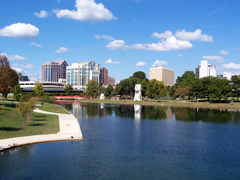Huntsville, Alabama: From Small Town to the Center for Space and Defense

Huntsville is an area in Alabama that experienced many changes throughout its lifetime. While it was initially started as a settlement, it grew to become a major center in the south for a variety of industries. Huntsville also has its heart in their love of sports, which includes football, baseball, soccer, hockey and roller derby. While the area loves most sports, it’s soccer that seems to hit the top of the charts. The many games and the soccer scoreboards are a testimony to the town’s devotion to sports.
The original name given to the Huntsville area in 1805 was changed due to the lack of support for the British. The new name honored the former citizen, John Hunt, who had to relinquish his stay and relocate further south.
As with many of the towns of the time, the railroad had a great effect on Huntsville. The immense cotton industry combined with the railroad opened the doors for incredible transport and trade. The Civil War caused a rift for the state of Alabama as the Huntsville is contributed many to the Confederate troops. After the war, Huntsville was designated as the state capital and the growth of the city spiraled upward from that point.
Post war days were times of progress with the construction of much of the infrastructure to support a growing population. The textile industry supported much of the town, with the mill in close proximity to the building of schools, churches, shops, entertainment, sports fields, stadiums and scoreboards.
Industry screeched to a halt with the arrival of the depression, but Huntsville had the cotton crop to fall back on. While this didn’t keep the area from feeling the effects of the depression, it did offer a survival option that cities and towns in other parts of the country couldn’t share.
The decision of the U.S. Government to build three facilities for chemical munitions in support of World War II branched out to make the Huntsville area attractive to other government interests. This trend continued and included missile installations, rocket development and all of the companies that supported the added industries.
Without previously being planned, Huntsville became the heart of the defense industry, which expanded in the 1960’s to the space industry. Most of the rockets that have been used by NASA have had a direct relationship to the companies in Huntsville. The building of the Marshall Space Flight Center bonded the city and the industry that seemed like it could not be broken. Huntsville’s growth in government facilities also gave it the reputation for being a center for high tech.
When the government decision to shelve the Apollo missions was made, this had a direct effect on the Huntsville area. At this point, much of the financial survival of the area was dependent upon the space programs and all of the supporting industries. This decision made a change in the area and the focus was shifted to other high tech industries such as telecommunications, CAD design, the manufacturing of DVD’s and products that were in high demand. This shift brought in new residents to the area as well as increased interest in the sports teams. Additional team fields and stadiums were built, an attendance is at an all time high to view the soccer scoreboards and see the points added as their team plays.
Historic areas of Huntsville have been revitalized and are a treat for any visitor to see. The variety of museums, including the space museums, combined with the parks, festivals, art galleries and golf courses have opened another genre for the area for tourists and visitors alike.
Sources:
//en.wikipedia.org/wiki/Huntsville_alabama
https://commons.wikimedia.org/wiki/File:Downtown_Huntsville,_Alabama.jpg


